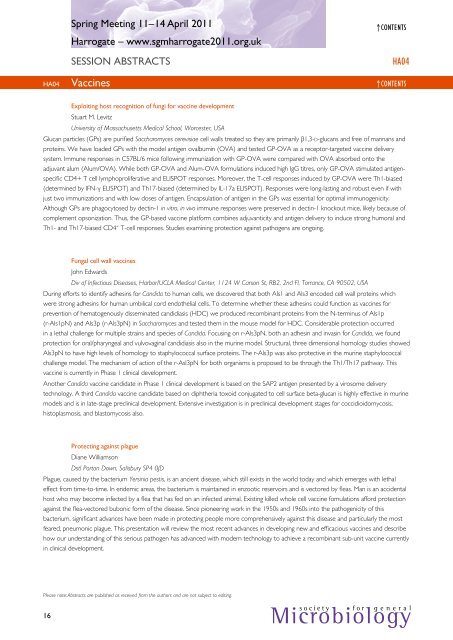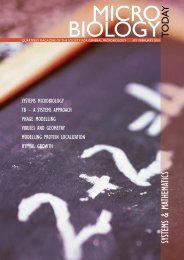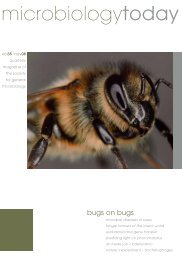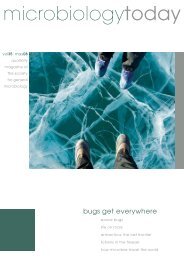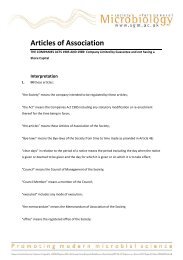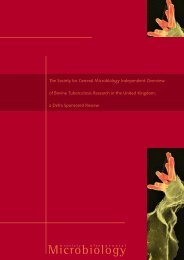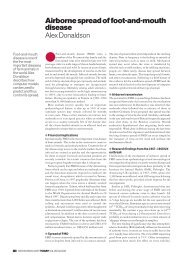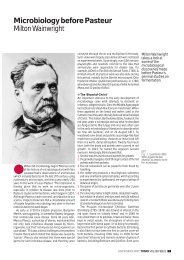Spring Conference 2011 - Society for General Microbiology
Spring Conference 2011 - Society for General Microbiology
Spring Conference 2011 - Society for General Microbiology
You also want an ePaper? Increase the reach of your titles
YUMPU automatically turns print PDFs into web optimized ePapers that Google loves.
Please note: Abstracts are published as received from the authors and are not subject to editing.<br />
16<br />
<strong>Spring</strong> Meeting 11–14 April <strong>2011</strong><br />
Harrogate – www.sgmharrogate<strong>2011</strong>.org.uk<br />
SESSION AbSTrACTS<br />
HA04 Vaccines<br />
↑Contents<br />
Exploiting host recognition of fungi <strong>for</strong> vaccine development<br />
Stuart M. levitz<br />
University of Massachusetts Medical School, Worcester, USA<br />
Glucan particles (GPs) are purified Saccharomyces cerevisiae cell walls treated so they are primarily β1,3-d-glucans and free of mannans and<br />
proteins. We have loaded GPs with the model antigen ovalbumin (OVA) and tested GP-OVA as a receptor-targeted vaccine delivery<br />
system. immune responses in C57Bl/6 mice following immunization with GP-OVA were compared with OVA absorbed onto the<br />
adjuvant alum (Alum/OVA). While both GP-OVA and Alum-OVA <strong>for</strong>mulations induced high igG titres, only GP-OVA stimulated antigenspecific<br />
CD4+ T cell lymphoproliferative and EliSPOT responses. Moreover, the T-cell responses induced by GP-OVA were Th1-biased<br />
(determined by iFN-γ EliSPOT) and Th17-biased (determined by il-17a EliSPOT). responses were long-lasting and robust even if with<br />
just two immunizations and with low doses of antigen. Encapsulation of antigen in the GPs was essential <strong>for</strong> optimal immunogenicity.<br />
Although GPs are phagocytosed by dectin-1 in vitro, in vivo immune responses were preserved in dectin-1 knockout mice, likely because of<br />
complement opsonization. Thus, the GP-based vaccine plat<strong>for</strong>m combines adjuvanticity and antigen delivery to induce strong humoral and<br />
Th1- and Th17-biased CD4 + T-cell responses. Studies examining protection against pathogens are ongoing.<br />
Fungal cell wall vaccines<br />
John Edwards<br />
Div of Infectious Diseases, Harbor/UCLA Medical Center, 1124 W Carson St, RB2, 2nd Fl, Torrance, CA 90502, USA<br />
During ef<strong>for</strong>ts to identify adhesins <strong>for</strong> Candida to human cells, we discovered that both Als1 and Als3 encoded cell wall proteins which<br />
were strong adhesins <strong>for</strong> human umbilical cord endothelial cells. To determine whether these adhesins could function as vaccines <strong>for</strong><br />
prevention of hematogenously disseminated candidiasis (HDC) we produced recombinant proteins from the N-terminus of Als1p<br />
(r-Als1pN) and Als3p (r-Als3pN) in Saccharomyces and tested them in the mouse model <strong>for</strong> HDC. Considerable protection occurred<br />
in a lethal challenge <strong>for</strong> multiple strains and species of Candida. Focusing on r-Als3pN, both an adhesin and invasin <strong>for</strong> Candida, we found<br />
protection <strong>for</strong> oral/pharyngeal and vulvovaginal candidiasis also in the murine model. Structural, three dimensional homology studies showed<br />
Als3pN to have high levels of homology to staphylococcal surface proteins. The r-Als3p was also protective in the murine staphylococcal<br />
challenge model. The mechanism of action of the r-Asl3pN <strong>for</strong> both organisms is proposed to be through the Th1/Th17 pathway. This<br />
vaccine is currently in Phase 1 clinical development.<br />
Another Candida vaccine candidate in Phase 1 clinical development is based on the SAP2 antigen presented by a virosome delivery<br />
technology. A third Candida vaccine candidate based on diphtheria toxoid conjugated to cell surface beta-glucan is highly effective in murine<br />
models and is in late-stage preclinical development. Extensive investigation is in preclinical development stages <strong>for</strong> coccidioidomycosis,<br />
histoplasmosis, and blastomycosis also.<br />
Protecting against plague<br />
Diane Williamson<br />
Dstl Porton Down, Salisbury SP4 0JD<br />
Plague, caused by the bacterium Yersinia pestis, is an ancient disease, which still exists in the world today and which emerges with lethal<br />
effect from time-to-time. in endemic areas, the bacterium is maintained in enzootic reservoirs and is vectored by fleas. Man is an accidental<br />
host who may become infected by a flea that has fed on an infected animal. Existing killed whole cell vaccine fomulations af<strong>for</strong>d protection<br />
against the flea-vectored bubonic <strong>for</strong>m of the disease. Since pioneering work in the 1950s and 1960s into the pathogenicity of this<br />
bacterium, significant advances have been made in protecting people more comprehensively against this disease and particularly the most<br />
feared, pneumonic plague. This presentation will review the most recent advances in developing new and efficacious vaccines and describe<br />
how our understanding of this serious pathogen has advanced with modern technology to achieve a recombinant sub-unit vaccine currently<br />
in clinical development.<br />
HA04<br />
↑Contents<br />
s o c i e t y f o r g e n e r a l<br />
<strong>Microbiology</strong>


